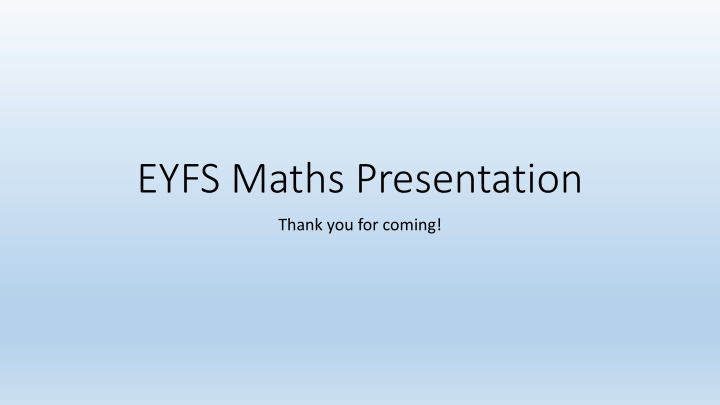



EYFS Maths Presentation Thank you for coming!
Aims • To outline the key areas of the Maths Curriculum • For parents to understand how we teach the children
Early Learning Goals Number Shape, space and measure • Children count reliably with • Children use everyday language to numbers from one to 20, place talk about size, weight, capacity, them in order and say which position, distance, time and money number is one more or one less to compare quantities and objects than a given number. Using and to solve problems. They quantities and objects, they add recognise, create and describe and subtract two single-digit patterns. They explore numbers and count on or back to find the answer. They solve characteristics of everyday objects problems, including doubling, and shapes and use mathematical halving and sharing. language to describe them.
How do children learn about maths at Irchester? • Carpet sessions linked to the topic and maths • Cross-curricular table top activities • Outdoor learning and problem solving • Lots of talking • Thinking • Self-discovery • Using manipulatives • Asking questions • Real-life learning • Booster groups – tri weekly maths groups
Estimating
Time?
Money
Exceeding/ further prep for year 1- Count in 2s, 5s and 10s.
5 principles of counting 1:1 counting- saying one number for each objects (move from one side to anther or line up) Stable Order- knowing the number names and saying them in the correct order Cardinal- the final number that you say is how many objects there are. Abstract- you can count anything; objects, things that can’t be moved, steps, claps, imaginary objects Order irrelevance- you can count objects in any order. Top to bottom, left to right etc.
Understanding of number
Addition and Subtraction
Recording using pictures, numbers and symbols
Sharing
Number sticks to play with at home • Choose a stick- what is one more/ one less • Choose two sticks- which is the most/ fewest? • Choose two sticks- how many altogether? • Choose three or more sticks- order them from most to fewest • Choose two sticks- take the fewest from the most
Recommend
More recommend